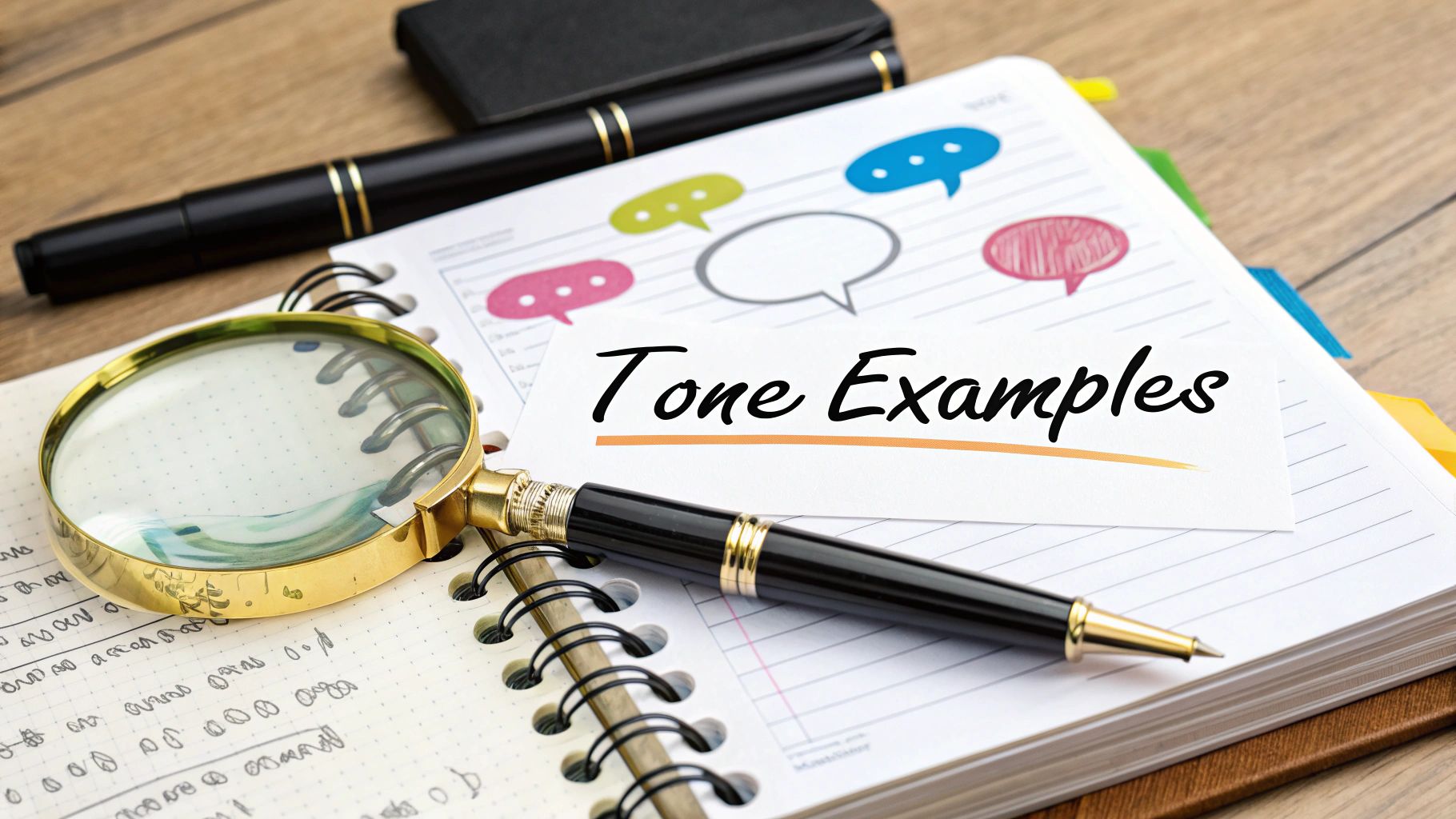
8 Powerful Examples of Tone to Improve Your Writing
Published on 2025-10-11
Have you ever read a post that felt instantly trustworthy? Or one that made you laugh out loud? That's the power of tone. The way you arrange your words is just as important as the words themselves, shaping how your audience perceives you, your message, and your brand. Get it right, and you build connection and drive action. Get it wrong, and you risk confusing or alienating your readers before they even get to your main point.
This guide is built to make you a master of tone. We will break down eight essential examples of tone that every professional should know, from authoritative to empathetic and humorous. This isn't just a list of definitions; it's a practical playbook. For each tone, you'll get a clear explanation and see it in action with a sample LinkedIn post.
Most importantly, we will dissect why each example works. You’ll get a strategic analysis, specific tactical insights, and actionable takeaways that you can apply to your own writing immediately. By the end of this article, you will have a complete toolkit to consciously choose and execute the perfect tone for any situation, ensuring your message always lands with maximum impact.
1. Formal Tone: For When Authority and Professionalism are Key
A formal tone establishes credibility and professionalism through precise, objective, and sophisticated language. It avoids slang, contractions, and overly personal anecdotes, focusing instead on clear, structured communication. This approach is essential when conveying serious information, such as in academic papers, official corporate announcements, or legal documentation.
Using a formal tone signals respect for the audience and the subject matter. It creates a sense of distance that reinforces authority and expertise, making it one of the most important examples of tone for professionals in conservative industries like finance, law, and corporate consulting.
Example LinkedIn Post
Subject: Q3 2024 Financial Performance Report Published
We are pleased to announce the official release of our Q3 2024 Financial Performance Report. This document provides a comprehensive analysis of the company's fiscal health, key performance indicators, and strategic initiatives executed during the third quarter.
The report details a 7% year-over-year revenue growth, primarily driven by successful expansion into new markets and the optimization of operational efficiencies. All relevant data and forward-looking statements are available for review.
We invite all stakeholders to access the full report via the investor relations portal on our corporate website.
Strategic Analysis & Actionable Takeaways
This post uses a formal tone to project confidence and maintain a professional corporate image. The language is direct, data-centric, and devoid of personal opinion.
- Tactic: Use specific, industry-standard terminology like "fiscal health" and "key performance indicators." This demonstrates expertise and speaks directly to a knowledgeable audience.
- Insight: The structure is logical and hierarchical, starting with the main announcement and followed by supporting details. This mirrors the structure of official corporate communications.
Key Takeaway: Employ a formal tone when your primary goal is to inform, not to entertain or engage in casual conversation. It is the best choice for official announcements, research findings, and communications where authority and precision are non-negotiable. Focus on objective facts and use a full, proper sentence structure to build trust.
2. Informal/Casual Tone: For Building Relatability and Connection
An informal tone is conversational, relaxed, and approachable, resembling everyday speech. It uses contractions, colloquialisms, and simpler vocabulary to create a friendly connection with readers, making it one of the most effective examples of tone for building community and brand loyalty.

This approach feels like a chat between friends, prioritizing accessibility over strict formality. It’s ideal for social media, blog posts, and brand communications aimed at a consumer audience, where the goal is to be seen as human and relatable. Explore a deeper dive into these different tones of writing to see how they compare.
Example LinkedIn Post
Subject: Whoa, what a week! Can we get a do-over?
Just wrapped up a massive project, and my brain feels like it’s run a marathon. You know that feeling, right? When you’ve poured everything into something and now you just need to… recharge.
It’s super easy to get caught up in the non-stop hustle, but I'm making a real effort to celebrate the small wins. This weekend, I'm ditching the laptop and heading for a hike. What's your go-to way to unwind after a crazy work week? Drop your tips below!
Strategic Analysis & Actionable Takeaways
This post uses an informal tone to foster engagement and build personal connection. The language is relatable, emotive, and invites direct interaction from the audience.
- Tactic: Use contractions like "it's" and "I'm" and conversational phrases like "You know that feeling, right?" This mimics natural speech and makes the message feel more authentic and less like a corporate broadcast.
- Insight: The post ends with a direct question, which is a classic engagement strategy. This transforms a simple update into a two-way conversation, encouraging comments and building a sense of community.
Key Takeaway: Use an informal tone when your goal is to connect, engage, and build relationships. It's perfect for personal branding, community-focused marketing, and internal team communications. Focus on being authentic and writing as you would speak, but always ensure your message remains clear and professional enough for the platform.
3. Optimistic/Positive Tone: For Inspiring Action and Building Morale
An optimistic tone focuses on hope, possibility, and positive outcomes. It uses uplifting and encouraging language to frame challenges as opportunities and inspire confidence in the audience. This approach is powerful for building community, driving motivation, and fostering a sense of shared purpose, making it a go-to for leaders, coaches, and brands aiming to connect on an emotional level.

This tone is not about ignoring difficulties; it's about acknowledging them while emphasizing the potential for growth and success. By highlighting solutions and forward momentum, it makes goals feel achievable and encourages perseverance. This is one of the most effective examples of tone for motivational content, team leadership, and brand storytelling.
Example LinkedIn Post
Subject: A tough week, but an even tougher team.
This week threw us some real curveballs, and I know the pressure was on. But watching this team come together, support each other, and find creative solutions has been the highlight of my year. We didn't just overcome a challenge; we built something stronger.
Every setback is a setup for a comeback. We’ve proven we have the resilience to turn obstacles into stepping stones. Let's carry this energy into next week and show everyone what's possible. I’m incredibly excited for what we will achieve together.
Strategic Analysis & Actionable Takeaways
This post uses an optimistic tone to reframe a difficult experience into a story of strength and unity. It acknowledges the struggle but quickly pivots to the positive outcome, boosting morale and motivation.
- Tactic: Use "we" and "together" to create a sense of shared experience and collective success. This fosters inclusivity and makes the positive message feel more personal and authentic.
- Insight: The structure moves from acknowledging a challenge to celebrating the team's response, and finally to looking forward with excitement. This narrative arc creates a powerful emotional journey for the reader.
Key Takeaway: Employ an optimistic tone when your goal is to motivate, unite, or build confidence. Acknowledge challenges to maintain authenticity, but immediately shift focus to the solutions and the potential for growth. Use forward-looking, active language to inspire action and make your audience feel capable and hopeful.
4. Humorous/Witty Tone: For When Personality and Engagement are Paramount
A humorous tone uses wit, wordplay, and clever observations to entertain while informing. It makes content memorable and shareable by creating an enjoyable experience for the audience, breaking down defenses, and humanizing a brand. This approach is powerful for standing out in crowded markets, as seen in campaigns by Dollar Shave Club and the famously sarcastic Wendy's social media presence.

Using a witty tone fosters a strong connection by making your audience feel like they are in on the joke. It can turn mundane announcements into viral moments and is one of the most effective examples of tone for brands targeting a younger, social-media-savvy demographic. However, it requires a deep understanding of your audience to avoid missteps.
Example LinkedIn Post
Subject: Another Monday. Another reason to question our life choices. Or just drink better gin.
That feeling when your weekend highlight was successfully assembling an IKEA bookshelf and your biggest professional achievement was unjamming the printer on the first try. We've been there. It's called 'adulthood.'
To celebrate these small, heroic victories, we're taking 15% off all Aviation Gin orders this week. Because if you have to face a spreadsheet, you might as well have a fantastic cocktail to look forward to. Responsibly, of course.
Strategic Analysis & Actionable Takeaways
This post uses a relatable, self-deprecating humor to connect with its audience on a personal level. The tone is witty and observational, transforming a simple sales promotion into entertaining content.
- Tactic: Leverage shared, mundane experiences (like IKEA furniture and printer jams) to create an immediate, relatable connection. This grounds the humor in reality.
- Insight: The wit supports the core message without overshadowing it. The transition from a humorous observation to the sales pitch feels natural, not forced.
Key Takeaway: Employ a humorous tone when your goal is to build community and make your brand more approachable. Ensure your humor aligns with your brand's personality and is well-understood by your target audience. Start with light, relatable wit rather than edgy or controversial jokes to test the waters.
5. Authoritative/Confident Tone: For When Expertise Must Be Unquestionable
An authoritative tone conveys expertise, confidence, and leadership through decisive language and definitive statements. It establishes the writer as a credible expert who provides guidance with certainty. This tone uses strong, clear statements without hedging or qualification, commanding respect and trust from the audience.
Seen in outlets like the Harvard Business Review or McKinsey & Company reports, this approach projects credibility. By removing ambiguity, an authoritative tone makes complex information digestible and trustworthy, positioning the source as a definitive guide. This is one of the most powerful examples of tone for building a reputation as a thought leader.
Example LinkedIn Post
Subject: The Only Metric That Matters in Early-Stage SaaS
Stop chasing vanity metrics. For early-stage SaaS companies, the single most critical indicator of future success is Net Revenue Retention (NRR). While user growth is exciting, NRR is the true measure of product-market fit and long-term viability.
A rate above 120% is the gold standard, proving your product delivers undeniable value that compounds over time. Companies that master NRR build sustainable, capital-efficient businesses. Focus your resources here. Everything else is a distraction.
We published a definitive guide on optimizing for NRR. The link is in the comments.
Strategic Analysis & Actionable Takeaways
This post uses an authoritative tone to cut through the noise and offer a single, clear directive. The language is commanding and leaves no room for debate, positioning the author as an expert with a proven perspective.
- Tactic: Start with a strong, imperative command like "Stop chasing vanity metrics." This immediately grabs attention and establishes a position of authority.
- Insight: The use of definitive statements ("the single most critical indicator," "everything else is a distraction") eliminates uncertainty and reinforces the writer's confidence in their expertise. This directness helps build trust with an audience looking for clear answers.
Key Takeaway: Use an authoritative tone when your goal is to provide clear direction and establish yourself as an expert. Back up your confident statements with specific data (e.g., "120% NRR") to substantiate your claims. This approach is ideal for thought leadership content where you are guiding your audience toward a specific conclusion or action. To further refine this approach, learn more about developing a strong brand voice.
6. Empathetic/Compassionate Tone: For Building Genuine Human Connection
An empathetic tone builds trust and connection by acknowledging and validating the audience's feelings, struggles, and experiences. It uses language that shows genuine care, understanding, and support, prioritizing the human element over corporate messaging. This approach is critical in fields like healthcare, mental wellness, and customer support, where making people feel heard and valued is paramount.
Using an empathetic tone demonstrates emotional intelligence and authenticity. It helps dismantle the barrier between a brand and its audience, fostering a community built on mutual respect and support. As one of the most powerful examples of tone, it is essential for communicators like Brené Brown and brands like Headspace that focus on wellbeing.
Example LinkedIn Post
Subject: It's okay to not be okay right now.
The pressure to constantly be productive can feel overwhelming, especially when you're navigating personal challenges. We want to remind you that your wellbeing comes first. It's perfectly fine to slow down, take a break, and prioritize your mental health. You're not alone in this.
This week, we're focusing on resources for managing burnout and stress. Remember, giving yourself permission to rest isn't a sign of weakness; it's an act of strength. Be kind to yourself today.
Strategic Analysis & Actionable Takeaways
This post uses an empathetic tone to connect with its audience on an emotional level, offering validation rather than a solution or a product pitch. The language is gentle, supportive, and deeply human.
- Tactic: Use validating phrases like "It's okay to not be okay" and "You're not alone." This directly addresses the reader's potential feelings of isolation and self-criticism, creating an immediate sense of safety and understanding.
- Insight: The message avoids "toxic positivity" by acknowledging the reality of struggle ("overwhelming," "burnout"). This authenticity makes the compassionate message more credible and impactful.
Key Takeaway: Employ an empathetic tone when your goal is to support and connect, not to sell. Acknowledge the audience's pain points and emotions without immediately pushing a solution. Use simple, direct, and gentle language to show you understand and genuinely care about their wellbeing.
7. Persuasive/Compelling Tone: For When You Need to Inspire Action
A persuasive tone is designed to convince readers to adopt a viewpoint, take an action, or make a decision. It artfully combines logical arguments with emotional appeals, using rhetorical techniques, compelling evidence, and strategic language to influence opinion. This goal-oriented tone is crafted to move an audience from passive observation to active participation.
Using a persuasive tone is essential for sales, marketing, and leadership. It bridges the gap between information and action, making it one of the most powerful examples of tone for anyone in a role that requires influence. A persuasive and compelling tone is vital for communication aimed at attracting new customers, such as when you aim to attract and retain high-value clients.
Example LinkedIn Post
Subject: Stop Settling for "Good Enough" Project Management
Is your team drowning in missed deadlines and chaotic communication? It's a common story, but it doesn't have to be yours. Imagine a world where every project finishes on time, under budget, and with zero confusion. That's not a fantasy; it's what happens when teams are truly aligned.
Our new workflow automation platform, FlowSync, was built to eliminate the friction that costs you time and money. We've helped companies just like yours reduce project completion times by an average of 35%.
Ready to transform your team's productivity? Click the link in our bio to see a 2-minute demo and start your free trial. The clarity you've been searching for is one click away.
Strategic Analysis & Actionable Takeaways
This post uses a persuasive tone by first identifying a common pain point and then presenting a clear, desirable solution. It blends emotional appeal ("drowning," "chaotic") with a logical benefit (35% time reduction).
- Tactic: Start with a relatable problem using a rhetorical question to immediately engage the reader and make them feel understood. This builds a foundation for presenting your solution.
- Insight: The post creates a contrast between a negative current state (chaos) and a positive future state (clarity, on-time completion). This "before and after" framing is a classic persuasive technique.
Key Takeaway: To be persuasive, you must connect with your audience's needs and emotions before presenting facts. Address their pain points directly, provide a clear and compelling solution backed by social proof or data, and end with a single, low-friction call-to-action that makes it easy for them to take the next step.
8. Objective/Neutral Tone: For When Unbiased Credibility is the Goal
An objective or neutral tone presents information factually without bias, personal opinion, or emotional language. It focuses on verifiable data and a balanced presentation of information, prioritizing accuracy and fairness over persuasion. This tone is crucial for building trust and establishing credibility in fields where impartiality is paramount.
Using an objective tone signals to your audience that the information is reliable and has been thoroughly vetted. It removes the author's personality from the equation, allowing the facts to speak for themselves. This makes it one of the most vital examples of tone for journalism, scientific reporting, technical documentation, and unbiased product reviews.
Example LinkedIn Post
Subject: Analysis of Q3 Social Media Platform Engagement Trends
A recent study analyzing user engagement across major social media platforms in Q3 2024 has identified several key shifts. Data indicates that short-form video content saw an average engagement rate of 5.8%, compared to 3.2% for static image posts and 1.9% for text-only updates during the same period.
The study, which surveyed 10,000 anonymized user accounts, also noted a 12% increase in direct message usage on Platform A, while Platform B experienced a 7% decline in daily active users. The full dataset is available for public review in the linked report.
Strategic Analysis & Actionable Takeaways
This post uses an objective tone to deliver data-driven insights without swaying the reader toward a specific conclusion. The language is precise, quantitative, and free of emotional or speculative adjectives.
- Tactic: Present data and statistics without interpretation or emotional framing. Phrases like "Data indicates" and "The study...noted" attribute the information to the source, not personal opinion.
- Insight: The structure is purely informational, presenting findings in a logical sequence. It refrains from making recommendations or predictions, which empowers the audience to draw their own conclusions based on the facts provided.
Key Takeaway: Employ an objective tone when your goal is to inform your audience with verifiable facts, not to persuade them. It is the ideal choice for reporting on research, presenting market data, or creating technical guides where trust and accuracy are the top priorities. Focus on what can be proven and cite your sources clearly.
Tone Style Comparison of 8 Examples
| Tone | 🔄 Implementation Complexity | ⚡ Resource Requirements | 📊 Expected Outcomes | 💡 Ideal Use Cases | ⭐ Key Advantages |
|---|---|---|---|---|---|
| Formal Tone | High – requires strict adherence to grammar and style | Moderate – careful editing and proofreading needed | Credibility and professionalism; clear, precise communication | Academic papers, legal docs, official correspondence | Establishes professionalism and clarity |
| Informal/Casual Tone | Low – natural, conversational style | Low – minimal editing, less rigid structure | Relatability and accessibility; reader engagement | Blogs, social media, personal emails, casual brand comms | Builds connection and authenticity |
| Optimistic/Positive Tone | Moderate – balanced positivity and authenticity | Moderate – crafting uplifting, genuine content | Motivation and emotional engagement; encourages action | Marketing campaigns, motivational content, nonprofit appeals | Inspires and uplifts audience |
| Humorous/Witty Tone | High – requires wit, timing, careful audience awareness | High – testing jokes; risk management | High memorability and shareability; strong engagement | Social media marketing, viral campaigns, entertainment content | Differentiates brand and captivates audience |
| Authoritative/Confident Tone | Moderate – confident, clear language use | Moderate – needs expertise and supporting evidence | Establishes trust and expertise; motivates action | Thought leadership, expert advice, leadership communications | Commands respect and trust |
| Empathetic/Compassionate Tone | Moderate – sensitive wording and genuine tone | Moderate – requires emotional intelligence and authenticity | Builds deep emotional connection; supports sensitive topics | Healthcare, mental health, customer service, crisis management | Creates loyalty and emotional trust |
| Persuasive/Compelling Tone | High – strategic use of rhetoric and calls-to-action | High – research, crafting argument and evidence | Drives specific actions and conversions | Sales copy, fundraising, political campaigns, advocacy | Highly effective for influence and action |
| Objective/Neutral Tone | High – demands unbiased, fact-based writing | High – requires verification and balanced coverage | Trustworthy, credible information; balanced viewpoints | News reporting, academic writing, encyclopedias, technical docs | Builds credibility and withstands scrutiny |
Choosing Your Tone: The Key to Authentic Communication
We've explored a wide spectrum of powerful writing tones, from the grounded confidence of an authoritative voice to the lighthearted engagement of a humorous one. Each of the examples of tone we analyzed, whether formal, persuasive, or empathetic, carries its own unique energy and is designed to achieve a specific outcome. The common thread is that tone isn't just about what you say; it's about how you make your audience feel.
The most successful communicators, especially on platforms like LinkedIn, don't just pick a tone and stick with it forever. They are masters of adaptation. They understand that a single message can be transformed by adjusting its delivery, making it resonate more deeply with its intended audience.
Key Takeaways for Mastering Your Tone
To move from understanding to application, remember these core principles:
- Audience First, Always: Your tone should be selected based on who you're talking to. A formal tone might work for a technical whitepaper announcement, but a more conversational, empathetic tone will be more effective for a post about team challenges.
- Context is King: The platform and the specific situation dictate the appropriate tone. A witty, informal post that thrives on Twitter might feel out of place in a serious company update on LinkedIn.
- Authenticity Builds Trust: Your chosen tone should still feel like you. Forcing a humorous tone when you're naturally more analytical will come across as inauthentic. Find the intersection between your brand's personality and your audience's expectations.
Your Actionable Next Steps
Mastering the art of tone is an ongoing practice, not a one-time decision. Here’s how you can start refining your voice today:
- Conduct a Tone Audit: Review your last ten LinkedIn posts. What tones did you use? Were they intentional? Did they align with your goals for each post? This quick analysis will reveal your default tendencies.
- Define Your Brand Voice: Spend time creating a clear guide for your communication. Documenting your primary and secondary tones is a crucial step in developing consistent social media branding guidelines that ensure every piece of content feels cohesive.
- Experiment Intentionally: Pick one new tone from our list for your next post. If you're typically very formal, try a more persuasive or optimistic angle. Observe the engagement and feedback to see how your audience responds.
Ultimately, your tone is the bridge between your message and your audience. By consciously choosing and honing it, you transform simple text into a powerful tool for connection, influence, and authority. The right tone doesn't just get your message heard; it ensures it is felt, remembered, and acted upon.
Struggling to find the right tone for every post? autoghostwriter uses AI to help you effortlessly adapt your message to various examples of tone, from authoritative to witty, ensuring your content always connects. Discover your perfect voice at autoghostwriter.